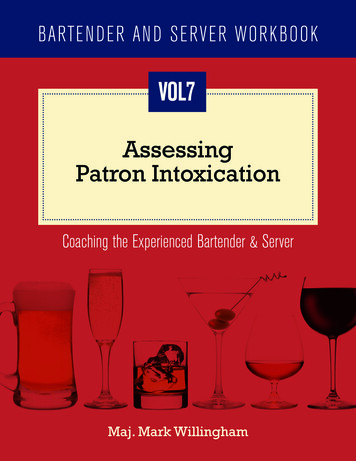
Transcription
BARTENDER AND SERVER WORKBOOKVOL7AssessingPatron IntoxicationCoaching the Experienced Bartender & ServerMaj. Mark Willingham
About the Author: Maj. Mark WillinghamMaj. Mark Willingham served with the Florida Division of Alcoholic Beverages andTobacco for twenty-eight years and provided beverage licensing, regulatory, and lawenforcement services as a Law Enforcement Commander. In addition to serving asthe Division’s Chief Financial Officer and Chief Training Officer, he served as Florida’sResponsible Vendor Program Administrator, Florida’s Youth and Alcohol ProgramAdministrator, and as a State Hearing Officer.Maj. Willingham is a PhD Candidate focused on responsible alcohol salespractices. He was the recipient of the Fulbright Fellowship in Police Studies to theUnited Kingdom where he conducted research on youth access prevention, regulationof the alcoholic beverage industry, and control of abusive drinking. Mark served asthe International President of the FBI National Academy Associates and has authoredfour books and over fifty articles in state and national law enforcement journals onleadership, management, and alcohol related issues. Major Willingham is a nationalspeaker on alcohol related risk, mitigation and responsible retailing issues.
BARTENDER AND SERVER WORKBOOKVOL7AssessingPatron IntoxicationCoaching the Experienced Bartender & ServerAlcohol Solutions, LLC.4839 Mariners Point Drive Jacksonville, Florida 32225 (904) 707-4400 mark@alcholsolutions.orgCopyright 2015 by Alcohol Solutions, LLC
Table of ContentsWelcome and Introduction.1Assessing Patron Intoxication Based on Behaviors.3Patrons’ Behavior Zones.3Guests in the Green.4Guests in the Yellow Zone.8Guests in the Red Zone. 10Involve All Employees in Observation and Assessment. 14Valets. 14Security, Hosts and Hostesses, and Greeters. 15Bus Staff. 16Let’s See What You Have Learned. 17
Bartender and Server Workbook: Path of Alcohol Through The BodyWelcome and IntroductionThe Coaching the Experienced Bartender series is designed for bartenders and serverslike you who are already skilled in the basics of serving alcoholic beverages. The objective ofthe workbook is to refresh your knowledge and awareness and build on your current skills andtraining to help you reach a new level of responsible alcohol service.One of the most important duties you have as a bartender or alcohol server is helping yourguests drink responsibly to promote a satisfying hospitality experience. It helps ensure thesafety of your guests and others in the community. Just like first responders, bartenders, alcoholservers, and other front of the house staff have a responsibility to protect the community. Youaccomplish this task by preventing your patrons from becoming intoxicated, by not servingintoxicated patrons, and by not allowing intoxicated patrons to drive away from your location.Your knowledge of responsible alcohol service and your ability to apply this knowledge isabsolutely vital to the success of your establishment and to the safety of your community.One of the most important duties you haveas a bartender or alcohol server is helpingyour guests drink responsibly to promote asatisfying hospitality experience.Public safety must be a personal and professional consideration of everyone in thealcoholic beverage industry. Professionals in the retail beverage alcohol industry must adoptand employ a personal value system for the safe service of alcohol and commit to preventingthe the sale of alcoholic beverages to underage persons, persons who are intoxicated, and/or persons habitually addicted to alcohol.It may be counterintuitive to those in the hospitality business to deny someone alcoholservice. Refusing service can place employees in a challenging and stressful situation.Sometimes putting limits on alcohol service is the best thing you can do for your patron.Alcoholic beverage service policies, practices, training, and management prepare and helpyou to provide your guests with a wonderful experience and help you to protect your guests,yourself, and others from alcohol-related harms. In the long run, guests and the community-1-
Bartender and Server Workbook: Path of Alcohol Through The Bodywill be grateful for your concern and action. You have the right to refuse service to anyone youdo not feel comfortable serving unless that refusal is based on the individual’s constitutionallyprotected rights (i.e., race, creed, color, gender, sexual orientation, religion).All front of the house and customer contact employees must be prepared to contribute toand support responsible alcohol service. This behavior applies to hosts/hostesses, servers,bartenders, bar-backs, bussers, valets, security, coat checkers, cashiers, managers, and foodrunners, and anyone else who comes into contact with guests.The workbooks in this series are designed to provide information to help you understandand implement the law and rules in your community, recognize and prevent intoxication,recognize and prevent alcohol service to and consumption by habitually addicted patrons,checking identification and preventing alcohol service to and consumption by persons under21 years of age, use of legal and illegal drugs with alcohol and the effect(s) of that poly-druguse on patrons, and difficult situations occurring in your establishment.Engaging in responsible alcohol service is not a once-a-year or a once-every-5-yearsactivity. It is a daily duty to your guests, your coworkers, your establishment, and yourself. Byapplying the skills you acquire and enhance through completing this series of workbooks, youwill make a significant contribution to responsible alcohol service.Some information presented builds on information presented in the NationalRestaurant Association’s ServSafe program, the American Hotel and Lodging Association’sCARE program, and Health Communications, Inc.’s Training for Intervention ProceedureS(TIPS) program.-2-
Bartender and Server Workbook: Path of Alcohol Through The BodyAssessing Patron Intoxication Based on BehaviorsDo some patrons exhibit signs of intoxication with as few as one drink?Circle your answer:YesNoHow often should you reassess your customer’s intoxication level?What is the presumptive BAC level for Driving Under the Influence DUI?Should your guests be allowed to drink more alcohol once they get to at this level?Circle your answer:YesNoIdentifying Patron Behavior ZonesPreventing customers from becoming intoxicated while they enjoy their visit to yourestablishment should be your primary goal. A number of responsible beverage service (RBS)training programs use what is commonly referred to as the traffic light system to help you dothat. In these programs, various behaviors associated with intoxication are attributed to oneof three colors of a traditional traffic light. A green light signals that you are OK to serve theguest. A yellow light means caution: you should stop or slow alcohol service until the guest’sbehavior returns to the green light zone. A red light means the guest is intoxicated and shouldnot be served.Your patrons are presumed to be intoxicated for the purposes of driving (and some otheractivities) at a 0.08 g% BAC. However, your patrons are actually beginning to becomeintoxicated at 0.04 g%. Their behaviors and judgments begin to change at that level. As a-3-
Bartender and Server Workbook: Path of Alcohol Through The Bodyresult, your concern and interest in their intoxication should begin before they reach the 0.08g% level.Guests in the Green ZoneIf a customer is in the green light zone, should you focus on determining baselines forthe patron’s behaviors?Circle your answer:YesNoIn the green light zone, should you monitor the number of drinks served to andconsumed by each patron?Circle your answer:YesNoGuests who have just begun to consume alcoholic beverages are usually identifiedwith a green light. Unless they have been drinking previously, They are good to GO foralcohol service.Your alcohol service goal with patrons identified by agreen light is to prevent intoxication and avoid alcoholrelated harms. When customers are in the green, you cansafely serve them alcohol, but you should pace the alcoholservice by striving to keep them in the green zone duringtheir visit to your establishment.After as few as one drink, some customers becomerelaxed and talkative. Each time a customer in the greenzone orders another drink, you should re-assess thecustomer to make sure he or she is still in the green.Monitor the number of drinks served to and consumed byeach patron. Interview the customer each time he or she orders an alcoholic beverages byengaging in a brief conversation with him or her when you return to the table. It’s easierto assess the guest’s behavior if you are monitoring consumption and paying attention to-4-
Bartender and Server Workbook: Path of Alcohol Through The Bodybehavior on an ongoing basis.Use your interaction with the guest as an opportunity to explain your designated driverprogram, policy, and specials (such as free non-alcoholic beverages for designated drivers).If your establishment serves food, encourage your guests to order food or snacks withtheir drinks. An effective way to reduce the rate of alcohol absorption is for your patrons toeat foods high in fat. Do not increase the pace of serving alcohol just because a customer iseating or in the green.High Fat Food You Can SuggestTo Keep A Patron in the Green Zone Items with cheese as aprimary ingredient(e.g., pizza, tacos) Items with beef as aprimary ingredient(e.g., burgers, steak, fajitas) French fries Deep-Fried Items Nachos Chips and DipsOffer and serve water on the side with all drinks, especially with drinks ordered straightup. Food and water dilute the concentration of alcohol in the stomach, and food keeps thealcohol in the stomach longer, delaying access to the small intestine, where 75% to 85% ofalcohol is absorbed into the bloodstream.Serve only one drink at a time to each guest.Don’t push drinks onto guests who do not want todrink; respect their wishes and offer non-alcoholicbeverages or beverages with a lower alcoholcontent. Don’t forget to offer food to accompanythe lower alcohol content beverages, too.You will probably find that slowing downalcohol consumption to avoid guests entering theyellow zone is easier than allowing them to enterthe yellow zone, at which point you will need todiscontinue alcohol service until they return to the-5-
Bartender and Server Workbook: Path of Alcohol Through The Bodygreen. If someone needs to stop drinking, do not hesitate to stop serving him or her. If youwant or need to slow down someone’s alcohol consumption, consider some or all of theseoptions: Serve drinks served straight-up with water on the sideThis option helps guests slow their consumption, helps to maintain hydration, and helpsdilute the alcohol already in the bloodstream. Remove empty glasses before replacing them with fresh drinksThe interval between removing the empty glasses and replacing them with fresh drinksallows you to pace guests’ alcohol consumption. The guest must finish one drink beforegetting another, which extends the period of alcohol absorption. It also encourages the drinkerto finish his or her ice as it melts, which further helps to dilute the alcohol and extends theperiod of consumption. Avoid pitcher service when serving a groupIt is challenging to monitor the amount of alcohol each memberof a party consumes from a pitcher, particularly if one person isdrinking more than the others. Having access to a pitcher allowspatrons to self-regulate alcohol rather than enables the bartender orserver to do so. If your establishment regularly offers pitcher service,ask the manager if you can price individual beers at the pitcherprice so that you can control the pace of alcohol consumption andthe timing of drink service. Slow down alcohol serviceOne practice to slow alcohol service is to not be as accessibleto a patron you believe may be close to the yellow zone. If yourestablishment offers table service, encourage wait staff to take analternate path to avoid walking past certain tables as frequently. Thegoal of this method is to delay the process of reordering additionaldrinks until the drinker has transitioned back into the green light zone. Just because you haveslowed down service does not mean you can or should stop monitoring patrons at the table-6-
Bartender and Server Workbook: Path of Alcohol Through The Bodyor bar. For example, the drinker may begin drinking from another person’s drink. Monitor thebehaviors of the members of the party, but do so from the safety of your position behind thebar. Remember, your goal is to control the timing of drink service and get the patron back intothe green light zone. Do not deliver a drink to one person at another person’s requestOnly respond when the drinker himself or herself asks for a refill. Do not let another patronset the alcohol consumption rate for another guest. Strongly suggest non-alcoholic or low-alcohol beverages in place of thealcoholic beveragesWait for the guest to reorder—don’t suggest or encourage the purchase of additionalalcoholic beverages. Serve a large glass of water before bringingthe next round of alcoholic beverages. Divert attention away from drinking to dancing,pool, or snacking. If one guest is rushing others into anotherround, try waiting until everyone is ready beforetaking drink orders for the next round. Deter buying rounds when there is more thanone drink per person on the table.Don’t forget to communicate with your fellow bartenders and servers if guests consumingalcohol move from your station to another. The strategy of slowing down consumption to allowthe drinker’s liver to do its job must be implemented on an establishment-wide basis. Guestsmay not always want to accept the situation but more often will often take your suggestionand slow their rate of consumption.-7-
Bartender and Server Workbook: Path of Alcohol Through The BodyGuests in the Yellow ZoneAre patrons in the yellow light zone intoxicated?Circle your answer:YesNoWhat behaviors do patrons in the yellow light zone often exhibit?Should you serve alcohol to guests while they are in the yellow light zone?Circle your answer:YesNoGuests who have begun to feel the effects of alcohol are identified by a yellow light.Once in the yellow zone, guests may show signs of relaxing and lowered inhibitions, whichare indicators of intoxication. A quiet guest may become overly friendly or an outgoing personmay become sullen and withdrawn. As inhibitions decrease, guests may seek to increase theiralcohol consumption rate.Guests in the yellow zone likely have a BAC level below 0.08%, but are intoxicated. Youneed to exercise caution in serving additional alcohol. Guests with a BAC below 0.08%generally exhibit some or more of the following behaviors:The Yellow Zone: Low EndIn the low end of the yellow zone, guests will demonstrate a feeling of well-being, relaxation,lowered inhibitions, and might mention feeling the sensation of warmth. They may behave withsome euphoria. They may demonstrate some minor impairment of reasoning and memory, andbe less cautious. Their behavior may become exaggerated and emotions intensified. Goodemotions are better, bad emotions are worse.-8-
Bartender and Server Workbook: Path of Alcohol Through The BodyThe Yellow Zone: High EndAt the high end of the yellow zone, there is a light impairment of balance, speech, vision,reaction time, and hearing. Like patrons in the low end of the yellow zone, those in the highend of the yellow zone behave with euphoria. Their judgment and self-control are reduced,and caution, reason and memory are impaired.A patron at the high end of the yellow zone may have a with BAC of 0.08% and is legallyimpaired. It is illegal for your guests to drive at this level. Your guests will probably believe theyare functioning better than they really are and may not understand your reason for intervening.It is much easier to deal with a guest at thehigh end of the yellow zone than if he or shetransitions to the red light.As mentioned, guests in the yellow light zone are already intoxicated. Serving them morealcohol may easily move them to the red zone, where they are a risk to themselves and others.Your goal is to give that guest’s system time to metabolize the alcohol he or she has consumedso that guest returns to the green zone. Remember, alcohol is metabolized at the rate of about2/3 of a drink per hour. Guests’ behaviors tend to lag behind their alcohol consumptionbecause it takes as long as an hour to fully absorb the alcohol contained in a drink. Only afterabsorption will the behaviors associated with that level of intoxication become fully evident.It is much easier to deal with a guest at the high end of the yellow zone than if he or shetransitions to the red light. Before you serve him or her another drink, ask yourself if younoticed any change in speech patterns or pronunciation, appearance, or actions to indicatepossible intoxication since you started serving him or her. Consider the guest’s gender, bodysize, amount of alcohol consumed, and number of hours drinking. Can the guest safely haveanother drink based on the BAC chart?Advise your manager about the situation to help prevent the guest from moving into thered. Strongly encourage the guest to eat. Although food consumption after a patron hasbecome intoxicated will not slow absorption of the alcohol already consumed, it may slow anysubsequent absorption. More importantly, it will give the drinker something to do and extend-9-
Bartender and Server Workbook: Path of Alcohol Through The Bodythe time before the drinker may insist on another alcoholic beverage.Strongly suggest non-alcoholic or low-alcohol beverages in place of the alcoholicbeverages being consumed if the guest is in the yellow zone. Remember to serve waterwith every drink. In addition to helping to dilute the alcohol in the body, drinking water slowsconsumption by giving the patron something else to do and may help quench his or her thirst.Remember, A guest in the yellow zone is intoxicated. He or she may be at or near 0.08g% BAC. Ensure that the guest will be safe if he or she wants to leave by calling a taxi,suggesting that the guest call for a ride, assuring that someone in the guest’s party will drive,or suggesting that the guest stay at the establishment or at nearby lodgings until he or sheis sober.Guests in the Red ZoneAre guests in the red light zone at significant risk of injury to themselves or others?Circle your answer:YesNoAre guests at the high end of the Red Light zone susceptible to alcohol poisoning?Circle your answer:YesNoGuests in the red zone are intoxicated and are at significant risk of injury to themselves orothers. Guests in the red zone are intoxicated to the point where they are a risk to themselvesand others. They require immediate intervention. When guests are at the red light stage, yourfocus should be on their safety. Remember, you have a responsibility for your guests.Alcoholic beverage service to a guest in the red must be stopped immediately. Don’ttry to go it alone. Guests in the red require a team effort. Know the procedures of yourestablishment thoroughly before you have to use them. Then, follow those procedures andinform your manager about the situation. You may want to have your manager or a coworkeravailable when you talk to the guest and tell him or her you can no longer serve alcoholicbeverages to him or her. It is your responsibility to protect guests in the red zone and othersthey may harm.- 10 -
Bartender and Server Workbook: Path of Alcohol Through The BodyDrinkers in the red zone are likely to exhibit various behaviors depending on whether theyare in the low end to mid-range of the red zone, in the mid-range to high end of the red zone,are in the high range of the red zone, or are at the high end of the red zone.The Red Zone: Low End to Mid-RangeGuests at the low end to mid-range of the red zone havesignificant impairment of gross motor coordination andloss of good judgment. Their speech may be slurred; theirbalance, vision, reaction time, and hearing will be impaired.They will likely demonstrate euphoria, but at lesser levelsthan in the yellow light zone. Instead of euphoria, they willlikely exhibit an increase in anxiety and restlessness. Theirjudgment and perception are now significantly affected.The Red Zone: Mid-Range to High RangeAt this stage, most drinkers exhibit a state of feeling unwell or unhappy. Anxiety, depression,and restlessness may predominate. The guest may begin to feel nausea. The drinker may alsohave the appearance of a “sloppy drunk.”The Red Zone: High RangeAt this stage your guest is extremely intoxicated. He or she is probably feeling and behavingas if dazed, confused, or otherwise disoriented. He or she may need help to stand or walk. Ifhe or she bumps into something or is otherwise injured, the intoxicated guest may not feel thepain. Some people experience nausea and vomiting at this level. However, the gag reflex canbe suppressed at this level and people can choke if they do vomit. Blackouts are likely at thislevel, so they may not remember what has happened.At the high end of the red zone, your intoxicated guest has substantial or completeimpairment of all mental, physical, and sensory functions. The drinker often has littlecomprehension of where he or she is. Passing out suddenly is common. It may be difficult toawaken the person who passes out at this stage. At extreme BAC levels, coma is possible.This level of intoxication is comparable to surgical anesthesia. At this BAC level, the patron- 11 -
Bartender and Server Workbook: Path of Alcohol Through The Bodymay die from alcohol poisoning as respiration and other body functions begin to declineand fail.Your responsibility for guests in the red light zone is to prevent further alcohol consumptionand to take action to ensure their safety. Remember, they are at risk due to falling and otheraccidents. They should not be trusted to act in a responsible manner or even follow thoughon their stated intents.Calmly and firmly state the policy and repeat it again if needed. Treat guests with respect,but be firm. Don’t make any judgments. If you can do so safely, move the guest away fromothers. Do everything you can to minimize the confrontation. Offer options besides alcohol.Remove alcohol from reach. Don’t make accusations or argue with guests. Just stay firm andstand your ground.Dealing with a Guest in the Red Zone Ask the guest to move away fromothers when speaking to him orher about the situation. Never touch the guest unlessgiven permission by the guest. Avoid judging the guest, raisingyour voice, or arguing. Don’t say,“You’re drunk” or “You’ve hadtoo much to drink.” Do say, “I’mconcerned about you” or “I careabout your safety!” Strongly encourage the guest toget something to eat beforeleaving your establishment ifpossible. Ensure that the guest will be safewhen he or she leaves by arrangingfor alternate transportation; asksomeone in the guest’s party todrive, ask the guest to call a friendor family member for a ride, orcall a taxi. If your establishmentoffers lodging, suggest that theguest stay on the property. Make sure the guest has all of hisor her personal belongings whenhe or she leaves. You don’t wantthe intoxicated guest to leave andhave to come back for his or herjacket, purse, or other item.- 12 -
Bartender and Server Workbook: Path of Alcohol Through The BodyConvince the guest that you are concerned about their welfare and safety. Aside fromphysically restraining someone, do everything you can to prevent an intoxicated guest fromdriving away. Do not let an intoxicated person drive away—or even walk away—even if thatmeans calling the police. It’s better to risk making the guest angry than to risk lives.If the guest will give you his or her car keys, give the keys to the manager and help theguest seek alternate transportation. If the guest will not give up his or her car keys and insistson driving, call law enforcement immediately. Keep the patron in full view until authoritiesarrive. Fill out an incident report.The safest course of action is to arrange for alternate transportation, which might include: Public transportation A sober member ofhis or her party Taxis Having someonepick up the patron A designated driverEven if you have arranged for alternate transportation, your responsibility does not endwhen you put a highly intoxicated patron into a cab. The drinker could simply tell the cab driverto stop at the end of the parking lot and get into his or her car and drive off. A better responsemay be to find a sober, responsible person the drinker knows to care for the drinker.There are instances when you simply must call the police to deal with an intoxicateddrinker, even if the drinker is not causing youtrouble. An intoxicated patron is a significantrisk to himself or herself and to others. Thepolice can assist in finding someone to carefor the intoxicated patron. The police arealso equipped to determine if the drinkeris in medical distress and may need to betransported to the hospital. It is better to riskan angry guest than to risk lives.- 13 -
Bartender and Server Workbook: Path of Alcohol Through The BodyInvolve All Employees in Observation and AssessmentWhich employees in your business are responsible for identifying intoxicated patrons?Bartenders or alcohol servers alone may not be able to observe and track the behaviors ofall bar or restaurant patrons. All employees and especially front of the house staff have equalresponsibility to monitor patrons for intoxication and inform servers and management of theirobservations. Observation and communication are especially important if guests move fromthe bar to another location, such as a table in the dining room.Depending on the number and type of staff at your establishment, the following employeesare integral in identifying patron intoxication: Valets Wait staff Bus staff Bartenders Security, hosts,hostesses, andgreeters Coat check andrestroom attendantsValetsValets often are the first people to make contact with guests upon arrival at theestablishment. A valet should be able to identify intoxicated guests and alert managementbefore the intoxicated person enters the establishment and attempts to obtain an alcoholicbeverage.- 14 -
Bartender and Server Workbook: Path of Alcohol Through The BodyAs the valet observes guests, he or she should ask themselves: Is the guest’s driving erratic? Did they have difficulty parking between the lines in the parking space? Did the guest have difficulty getting out of the car or walking? Is the guest having difficulty talking? Does the guest exude the odor of alcohol?If you can answer yes to any one of these questions, there may be cause for concern andyou should notify your manager. If you suspect a guest is intoxicated, never ask him or her toleave the premises in that condition. You should take steps to keep that person from gettingback into his or her car and leaving in that condition.Security, Hosts and Hostesses, and GreetersSecurity staff, hosts and hostesses, and/or greeters often are the first people to makecontact with guests once they have stepped inside the establishment. Security staff, hostsand hostesses, and/or greeters should use their encounter with the guest as an opportunityto talk to the guests and to observe the following: Are they speaking rationally? Is their speech slurred? Are they able to make eye contact and focus while talking to you? Can they walk without staggering, stumbling, or bumping into objects?- 15 -
Bartender and Server Workbook: Path of Alcohol Through The BodyBus StaffBus staff are in a unique position to observe guest behavior. Bus staff work throughout theestablishment and have the opportunity to listen to how guests speak and to observe thefollowing: Are they getting louder as time passes? Are they becoming overfriendly, or are they beginningto use foul language or becoming rude? Have they started spilling drinks or food on the table? Are they having difficulty talking? Are they beginning to look tired or sleepy?Each of these employees should be trained to recognize signs and behaviors of intoxicationand be instructed to contact the bartender, alcohol server, and the manager if they observeany signs of intoxication.It is interesting to note that at least one major national responsible beverage service trainingprogram has discontinued the use of the traffic light system. They found that the yellow zonewas often misunderstood and some servers allowed additional drink service which quicklypushed their patrons into the
Bartender and Server Workbook: Path of Alcohol Through The Body - 1 - Welcome and Introduction The Coaching the Experienced Bartender series is designed for bartenders and se

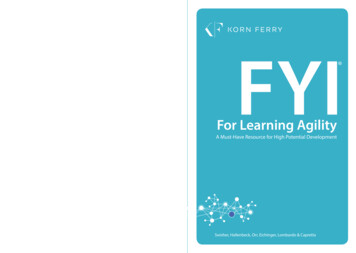

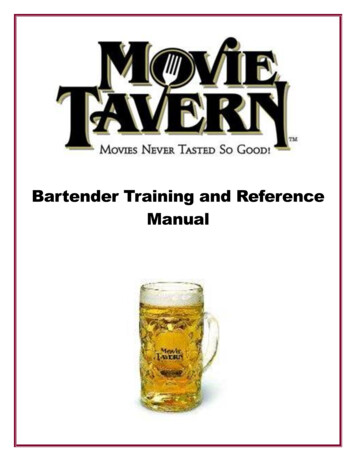
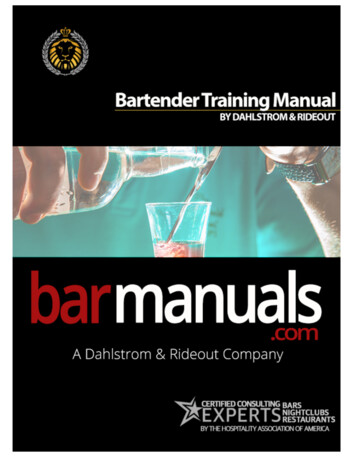
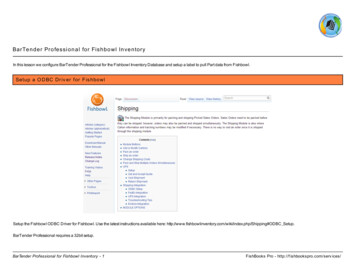
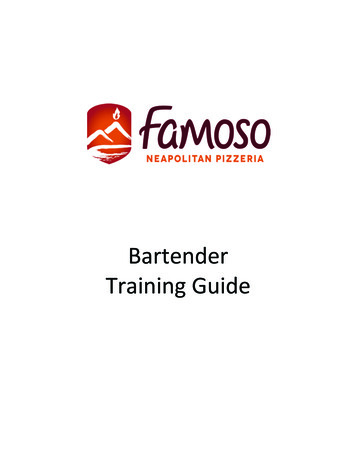
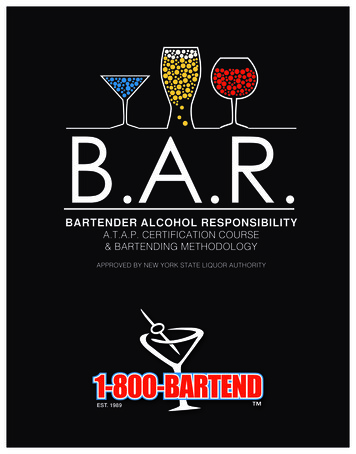

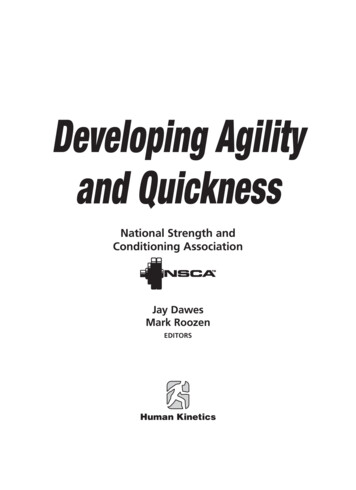
![Josh Smith - Agility [Read-Only]](/img/8/disaster-planning.jpg)